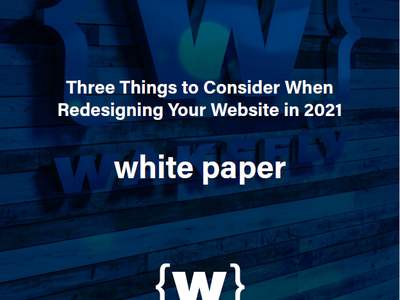Posted on 9/1/2015 in UX and Design
By Matt Wiseley
It’s that time. Your web site design looks dated and tired. Performance has flatlined or is declining, and consensus is calling for a redesign.
When establishing a budget for your website redesign project, consider whether using a template is the right choice for you. Using a template can save time and money on both the design and development of your project. The money saved could be put towards marketing the site or reallocated to building more engaging features or integrations that would otherwise be out of reach.
Dealing with Template Naysayers
Using a template is often frowned upon with the assumption that only low budget website projects would go there. When people hear “web template”, they think of cookie-cutter design without personality.
This thinking is misguided.
Consider this. When you hire a professional to design your website, do you expect them to start from a completely blank slate and come up with something 100% original? Doing so would be leaving behind every best practice and intuitive user experience paradigm available.
Look at a dozen websites that successfully serve a similar purpose for a similar audience and you’ll see a lot in common. A designer’s task is to collect and assemble these best practices along with a color palette, imagery and branding language that best serves your visitors.
At this point, there is very little that is truly original in web design. Yes, there is a time and a place for that building a custom website completely from scratch, but is trying out the web’s first helix-shaped navigation menu really going to best serve your visitors?
Benefits of Using a Template
Using a template provides two main benefits.
First, it is a starting point for your site’s design. There’s a good chance your designer will leverage a template of some kind for this purpose regardless, so you might as well reap the benefit and ask for it. Rather than work out all of the content structure, placement, navigation and responsive behavior, a well-chosen template provides this out of the box. By browsing available templates and finding one that works, you can save a lot of time and money during the design portion of your project. Once a template is selected and agreed upon, the designer is simply modifying your template starting point.
Second, if you select the right type of template, it provides the starting point for your site’s development. At Wakefly, we build most of our websites using the Bootstrap framework, and there are lots of high-quality Bootstrap templates available for almost any purpose. Provided that you don’t make huge structural changes to the selected template, a Bootstrap template cuts out a substantial amount of work in converting designs to a Bootstrap template – it’s work that has to happen one way or the other.
Template-Based Design Process
For those who argue that your design will suffer from the use of a template, rest assured that a professional designer knows what to change and what to keep from a template to make it look entirely yours. By changing colors, images and text, almost all of what a visitors thinks of as the “site’s design” has been replaced while the heavy lifting of layout and front-end coding is done.
If you decide to take the template route on your next project, be sure to consult with your agency or designer on what type of template you should be looking for. You may want to browse available templates yourself and pick one or work with a designer to select one for you. Once the template is selected, the real design begins.
Struggling to get more visitors to your site?
Request a Free SEO Audit of Your Website!Related Articles

How Do I Optimize My Website for AI?
Why do you need to optimize your website for AI?AI-powered search engines like Google’s AI Overview, Perplexity, and tools such as Microsoft's [...]

Outdated or Outstanding? How to Tell If Your Website Needs a Refresh
Your website is the digital face of your business. It serves as a first impression, a marketing tool, and a resource for potential customers. [...]

Preparing a Website Redesign Budget for 2025: A Step-by-Step Guide
As we approach 2025, businesses are recognizing the necessity of a fresh, user-friendly website to stay competitive in a rapidly evolving digital [...]

